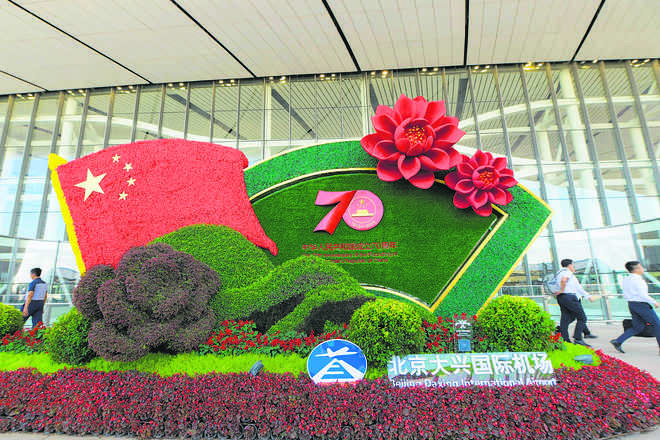
Test: The Communist Party of China faces the challenge of adapting the Chinese political system to meet the growing needs of a pluralised and empowered society.
Yogesh Gupta
Former Ambassador
AS the People’s Republic of China (PRC) celebrates its 70th anniversary, its exultation at its great achievements is understandable. China’s economy has become the second biggest in the world with a GDP of $13.4 trillion (2018), the per capita income has grown to about $10,000 and it accounts for 15 per cent of the global GDP. In 1949, PRC was a poor country, its people were hungry, the average life expectancy was 35 years with 80 per cent illiteracy and 20 per cent infant mortality rate. China’s Human Development Index has escalated from 0.502 in 1990 to 0.752 in 2017, with life expectancy now at 76 years, illiteracy at 5 per cent and infant mortality down to 1.5 per cent.
This journey of 70 years has been extremely tumultuous, with the death of several million Chinese during the Great Leap Forward (aimed at transforming China through industrialisation and collectivisation, 1958-62) and the Cultural Revolution (to purge the Communist Party of China or CPC of Mao Zedong’s enemies and purify its ranks, 1966-76). China made considerable headway in land reforms, water conservation and removal of illiteracy during 1949-79 that formed the bedrock for huge progress under paramount leader Deng Xiaoping when he initiated reforms of the economic system; the latter included a sharp increase in the procurement price of farm products; the autonomy of enterprise managers, allowing them to retain profits; and encouraging Chinese companies to engage in private trade with foreign firms. These and other changes allowed China to register an average annual growth rate of 10 per cent from 1978 to 2010. Much of this growth was due to China’s booming exports, which accelerated after the grant of the ‘most favoured nation’ status by the US in May 2000 and the facilitation of its admission into the WTO in 2001.
When Xi Jinping took over as the head of the CPC in November 2012, he found a very different China from that of Deng Xiaoping: Chinese people had acquired money, talent and information, corruption had spread in the party and the military, even senior cadres’ loyalty to the CPC was suspect and there was talk of shifting to a more democratic system of government akin to the Singapore model. Xi Jinping, who was appointed to save the party, immediately ordered measures to weed out corrupt elements (including his critics), ruthlessly establishing the party’s control on state and private enterprises, universities, media and human rights institutions making it clear that the CPC came before everything else. The CPC is worried how the failure of the Russians to stand up for their party led to the disintegration of the Soviet Union.
How does China view its place in the world? In a 2017 speech to the CPC, Xi Jinping said, “China has stood up, grown rich, is becoming strong and its ultimate goal was to become a global leader.” Projecting himself as a ‘transformational’ leader like Mao and Deng Xiaoping, Xi Jinping unveiled his ‘dream’ of national rejuvenation of making China a ‘powerful socialist country’ by 2049, when it completes 100 years. Towards this objective, Xi Jinping has undertaken several initiatives such as the rapid build-up of China’s military capability of projecting power overseas, acquiring national sufficiency in 5G, semiconductors, artificial intelligence and quantum technologies and Belt and Road Initiative (BRI) to set up a China-dominated economic architecture in Eurasia as a rival to the transatlantic architecture led by the US. He has also prolonged his own stay in power, removing the two-term limit.
China’s rapid economic development using unfair trade practices such as the denial of market access, theft of intellectual property, forced transfer of technology and a state-subsidised model of economic growth has earned the wrath of the US. The latter has started ‘economic decoupling’ to weaken China in the long run, impose tariffs and sanctions against certain Chinese technology and nuclear power companies to maintain its dominance in ‘emerging technologies’ and resist China’s growing power through freedom of maritime operations in the South China Sea, fresh arms sales to Taiwan and build potential allies like India and Vietnam. China’s regional neighbours, perturbed about its growing assertiveness, interference and militarisation of disputed territories in the South China Sea and Xinjiang, are seeking new strategic and political alignments to deal with China’s growing might.
Millions of Muslims, including Uighurs, Tibetans and others, are deeply concerned about China’s denial of human rights, its ‘cultural policing’ and intrusive surveillance which violates basic freedom and privacy. Civil disorder in Hong Kong over the denial of democratic rights is generating fresh anxieties on whether China can maintain its ‘special status’ in accordance with the ‘one country, two systems’ principle which it had previously agreed upon, without resorting to extreme violence. The space available for critics and dissidents has been sharply constricted under the present leadership as it wants to brook no opposition to the absolute power of the CPC.
Over time, while China’s leadership has become relatively weaker, its people have become empowered and aspirational, seeking more jobs, education, health and housing facilities. The Chinese society is now dominated by important constituencies such as the big, medium and small business owners, professionals, bureaucrats, military, migrant workers and others with diverse interests. An important challenge for the CPC is whether it can adapt the Chinese political system to meet the growing needs of a pluralised and empowered society. The Chinese economic miracle was fuelled by a large and youthful labour force, rapid urbanisation, continuing market reforms and globalisation — factors which have now diminished. Another test for China is whether it can meet the rising expectations of its people while maintaining the CPC’s supremacy, even as its economic growth is declining amid the escalating trade war with the US.
Historically, China has achieved rapid economic progress when it was a more ‘open’ country with less government control, was part of the global supply chain and co-existing peacefully in the global political order. In important ways, China has digressed from this track. Another big challenge for the Chinese leadership is whether it can seek the path of restraint, accommodation and legitimacy, at home and in dealing with major powers and its neighbours, to avoid confrontation, build on consensus and strengthen peace, stability and security.



























